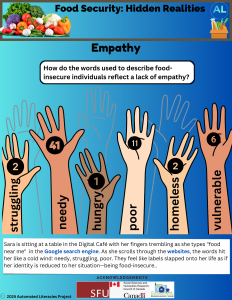By Sheree Rodney October 24,2024
Automation is playing a growing role in access to food, intervening in many places along food-insecure people’s path to food banks. While digital tools can streamline access to resources, they can also make visible the significant hurdles by giving the impression that everything is always accessible everywhere. Many individuals navigate multiple websites to find food resources or to locate food banks, which can be time-consuming and frustrating. Despite extensive online searches, getting to a physical food bank can often involve long and complicated commutes. This series of infographics illustrates the hidden realities of food bank automation. While they visually represent complex data, they also tell a compelling story of the human impact of food bank automation.
Distance Travelled
Online food bank directories make it seem like resources are readily available nearby. However, digital maps reveal that the actual distance between a person’s location and the nearest food bank can lead to unexpected cost and time to commute, making it even more challenging for individuals to access the resources they need.
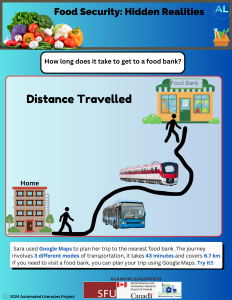
Time and Costs
When food-insecure individuals use automated search engines to locate food resources, the costs and time invested can be significant. While digital platforms offer convenience, they often require individuals to navigate complex interfaces. The cost and time spent travelling to food banks can be substantial and impactful on individuals already faced with a stressful situation.
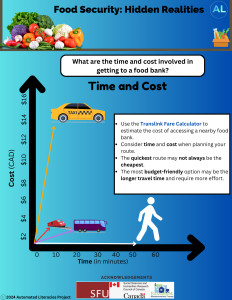
User Click Challenge
Searching for food and food resources can be a daunting task for the food-insecure. This infographic emphasizes the potential difficulties involved in using online resources to access food. These organizations featured in this infographic were randomly selected from the pool of websites used in our analysis. We aim to inspire developers and organizations to take action to develop more inclusive and accessible online platforms for connecting people with food. While these platforms can be user-friendly for certain audiences, those in need may struggle to find the resources they seek. It highlights a missed opportunity for better alignment between design priorities and the needs of food-insecure users.
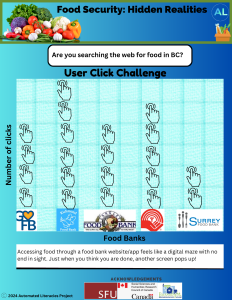
Website Audience
This infographic sheds light on the challenges food-insecure individuals encounter when using food bank websites. While some users may find the information easily accessible, those experiencing food insecurity often struggle to locate essential resources. For example, donation icons are prominently displayed—sometimes in multiple locations—whereas individuals seeking food must spend considerable time searching for the support they need.
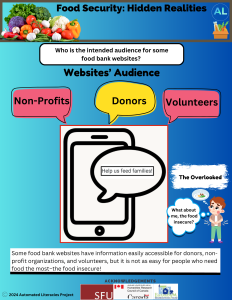
Empathy
The words used by food bank websites often reflect a lack of empathy that ends up reducing individuals to their hardship rather than acknowledging their dignity and resilience. These terms frame food-insecure individuals as victims of their circumstances and perpetuate stigma. In this infographic, we highlight some of the words commonly found on food bank websites along with how frequently they appeared. This analysis raises an important question: How could we use language in ways that focus on partnership, support, and shared humanity?

